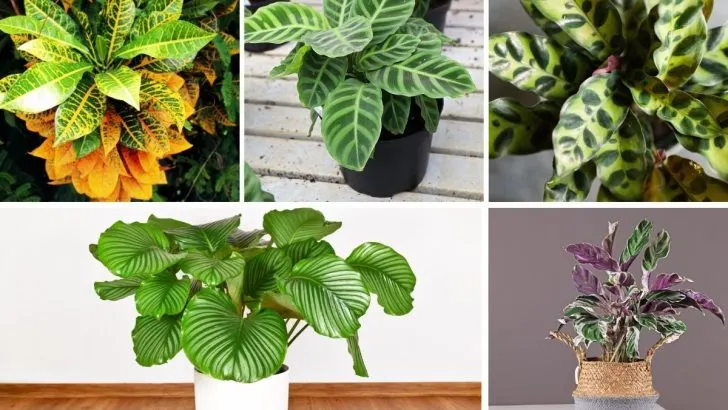Do you want to choose new plants for your home between pale green leaves and dark green coloring plants? What do you think about the types of prayer plants?
You’re not sure if you want purple spots on your plant or dark green spots? Hmm, should I choose paddle-shaped leaves? Do you want slow grower plants as well?
You are in the right place! Whichever you choose, it will be a great plant for your hanging basket, dark purple or lighter green, it doesn’t matter.
Bloody prayer plants along with other types and their oval-shaped leaves will look amazing in your home!
1. Prayer Plant Care Guide
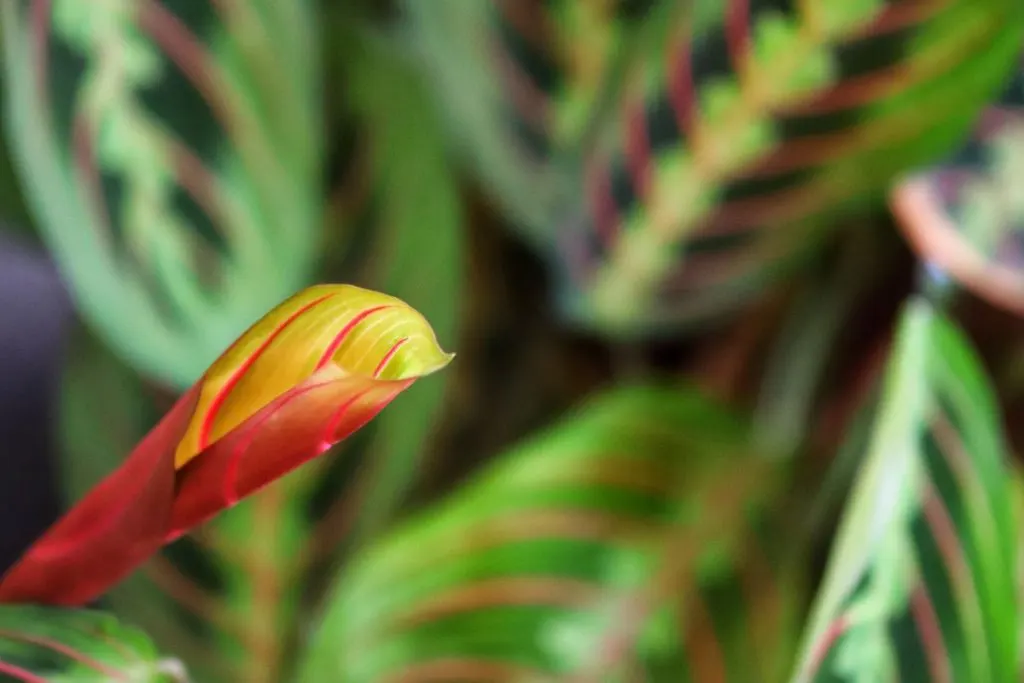
Mostly, these plants will have dark green leaves, dark green stripes, dark leaf veins, and pale green blaze, and now, we’re talking about the most popular type of prayer plant called the rattlesnake plant. Once you have it as your indoor plant, you will adore it!
• Light Conditions
Hang or place prayer plants near windows exposed to indirect sunlight. Do not expose the plant to direct sunlight as the sun will burn the leaves of the plant, spot the leaves and dilute the color.
• Soil Type
Prayer plants can grow in a variety of soils as long as they are well drained. Traditional culture soils usually work well, but you can make your own by combining two parts of sphagnum moss, one part of loamy soil, and one part of pearlite or coarse sand. Also, the soil should be acidic and the pH should be 5.5 to 6.0.
• Water Routine
Water the prayer plants frequently during the growing season to prevent the compost from drying out completely. These plants are very susceptible to drought and cannot survive long without water.
• Temperature And Humidity
Prayer plants prefer normal home temperatures between 60 and 80F. Prolonged low temperatures can damage the leaves and cause them to fall off the plant. Also, prayer plants work best in very humid environments.
• Fertilizer
From early spring to autumn, every two weeks (once a month in winter), the water-soluble foliage plant fertilizer is diluted in half and fertilized.
If you use too little fertilizer, the plant will grow slowly or almost disappear. However, too much fertilizer can burn the roots of the plant. The leaves begin to turn brown and the plants can even die.
2. Kim Prayer Plant
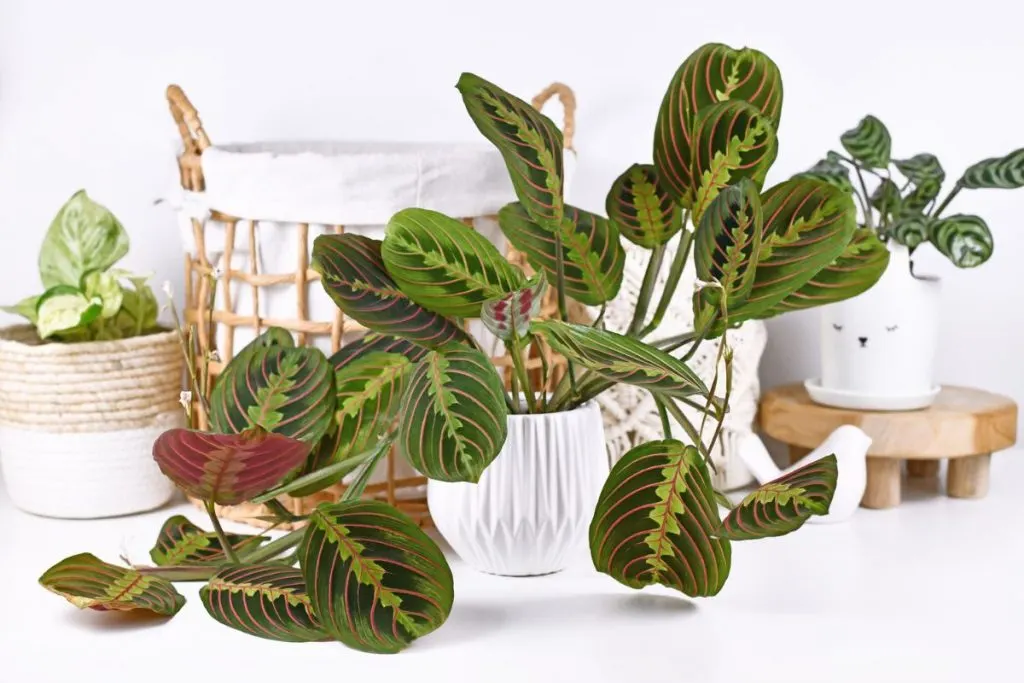
Maranta leuconeura or a Kim prayer plant is a well-known houseplant in temperate regions. Its amazing green mosaic on the leaves will leave you breathless and you’ll have to have it! Green markings on this plant are very unique and recognizable.
- Light Conditions
This plant just loves the shady location and can stand and grow well in bright light conditions. Direct sunlight is a big no for this plant even though it’s not very bright and pale green.
- Soil Type
The best possible soil you can choose for this plant is loose soil composed of sand, peat moss, cow manure, and good loam. Leaf loam works as well for this lovely green beauty.
- Water Routine
This plant doesn’t need or like much water. You can water it once a week when you notice that its soil is dry. Of course, this isn’t always the same since the watering routine depends on the growing area as well. If the air is dry and it’s exposed to more sun than it’s supposed to, then it needs a bit more water than usual.
- Temperature And Humidity
The best temperature for the Kim prayer plant is between 60 and 65 F. Everything below or above is a bit risky since it’s very sensitive to temperature change. High humidity and medium humidity are both great for the Kim prayer plant. If humidity isn’t high enough, buy an air device to increase the humidity.
- Fertilizer
Use a balanced liquid fertilizer for a Kim prayer plant.
3. The Rattlesnake Plant (Goeppertia Insignis)
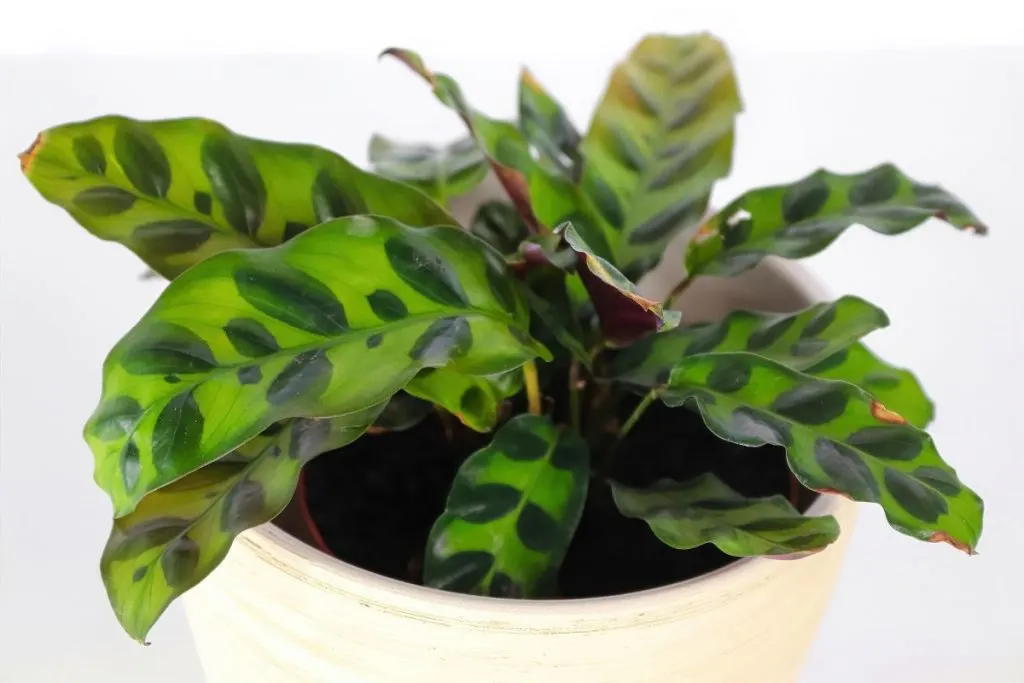
The rattlesnake is a tropical evergreen perennial plant native to Brazil. And it is commonly cultivated as a foliage plant.
It can be difficult to clean, but with the necessary care, it has a wavy pattern on the edges and a variety of green shades that beautifully project the unique autumn leaves.
- Light Conditions
Filtered light is the best option. If you want to put rattlesnake plants in windows, choose ones that are not exposed to the strong afternoon sun, or use curtains to diffuse the light. A bright place in a bright room works well.
- Soil Type
Choose well-drained soil. These plants do not tolerate stagnant water but prefer to keep them moist. Light sandy soil or potting soil with two parts of peat moss and one part of pearlite works well. Rattlesnake plants prefer slightly acidic or neutral pH levels and you should avoid alkaline soils.
- Water Routine
During the summer when rattlesnake plants are most active. Watering is required frequently to keep the soil or potting soil moist. In winter, the top layer of soil is dried and then re-watered.
- Temperature And Humidity
The ideal temperature for this plant is 60 to 75 F. Prolonged lower temperatures can cause the leaves to wilt and turn brown, eventually dying. Cold and dry air, poor ventilation, and sudden temperature changes are extremely harmful.
Keep rattlesnake plants away from air conditioners and heaters to avoid exposure to unwanted dry air.
- Fertilizer
During the spring and summer growing season, feed rattlesnakes every month. Use a balanced liquid fertilizer to promote healthy leaf development. Follow the instructions on the product label for usage.
4. All About Peacock Plants
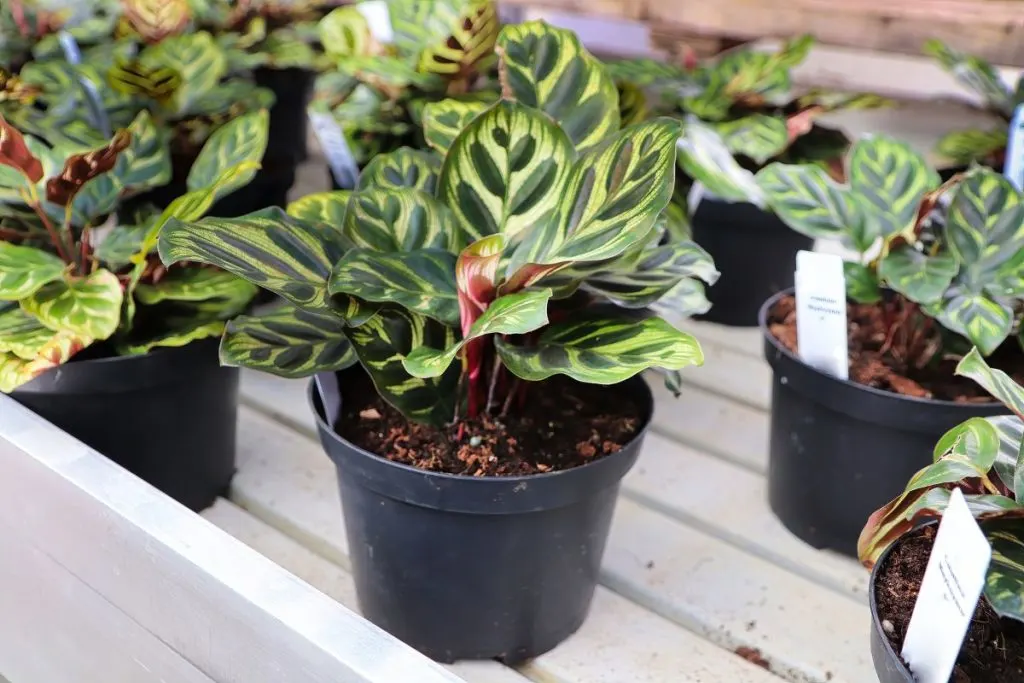
Sometimes referred to as the peacock plant, is officially known by its common name (and cathedral windows) as Makoyana.
This is because the striking pattern of wide leaves resembles the famous tail feathers of birds.
- Light Conditions
Despite being a tropical species, peacock plants are not fans of intense direct sunlight. This can result in a lighter leaf pattern and color. Filtered light conditions are recommended. But these plants can also grow in full shade, which can significantly slow down their growth.
- Soil Type
For peacock plants, it is necessary to select a well-drained potting soil that retains water. In most cases, a mixture of peat, sand, and perlite is recommended.
Humus and organic matter must also be abundant to ensure the production and color of lush, vibrant leaves.
- Water Routine
For peacock plants, it is important to find the right balance of watering. If the leaves start to curl, it can be a sign of being underwater. Too much water can cause root rot. These plants like consistent and even moisture levels.
- Temperature And Humidity
The ideal temperature for your peacock plant to thrive is between 60 F and 75 F. It is also important to ensure that plants are not exposed to sudden and extreme changes in their environment.
Cold drafts and sudden temperature changes can be problematic. High humidity is also the key to the prosperity of peacock plants.
- Fertilizer
Feeding peacock plants from spring to autumn during the growing season is another important consideration. Taking into account the abundant production of leaves. It is recommended to feed every other week with diluted liquid fertilizer.
5. Zebra Plants And Their Care Guide
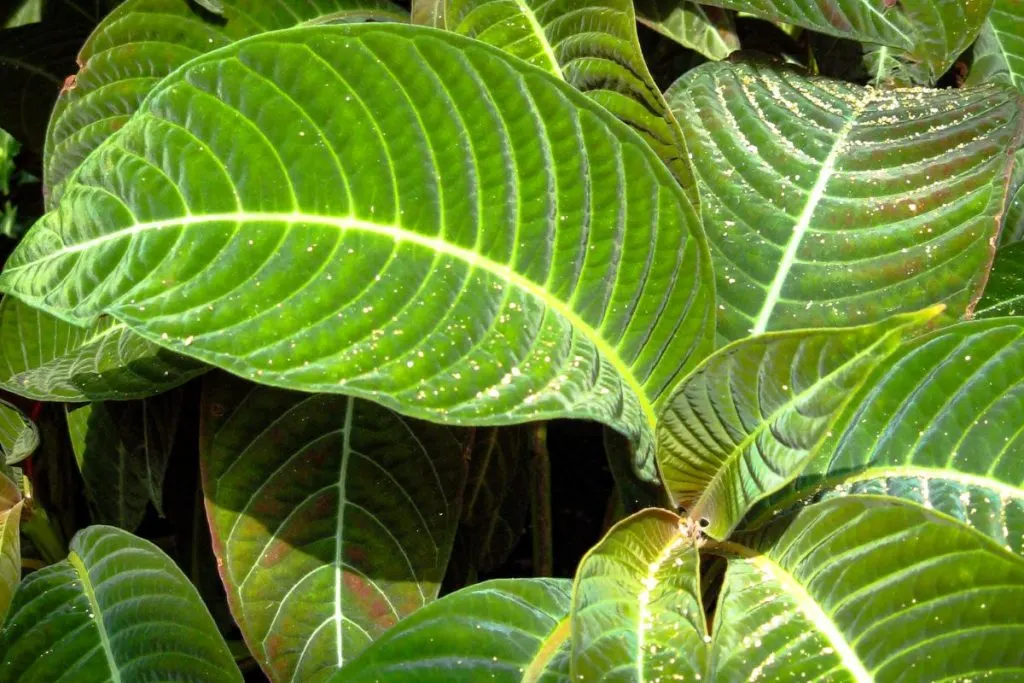
Zebra plants are usually grown indoors and are loved for their distinctive dark green leaves with white veins. The jewel of this plant is its colorful flowers.
- Light Conditions
Zebra plants are accustomed to growing under canopies in warm and moist climates. They breed in indirect light or partial shade. Avoid direct sunlight as it can burn the leaves, but full shade can prevent the plant from blooming.
- Soil Type
Zebra plants grow best on neutral to acidic soils. A versatile potting mix works well for zebra plants-you can also add sand to the mix to improve drainage. If a flowering plant is your goal, fertilize it weekly or for two weeks during the growing season.
- Water Routine
As mentioned earlier, zebra plants consistently prefer moist soil. Over-watering can cause the leaves to wilt and may require some finesse.
Her water temperature needs to be a little lukewarm, so she mimics the variables of sticky storms in warm climates, but only the water under the leaves, never from above.
- Temperature And Humidity
Due to their origin, zebras grow best at moderate temperatures. Its growth location should reach above 60 F and not below 55 F.
Humidity is also important for zebra plants, so the space should be kept at 60-70 percent humidity.
If these conditions cannot be achieved naturally indoors, a humidifier can be used to increase the humidity level.
- Fertilizer
The use of fertilizers can significantly increase the growth of zebra plants, especially when it comes to flowering ability.
During the main growing season, zebra plants should be fertilized weekly for 1-2 weeks with fertilizers suitable for both leaves and flowers.
6. Calathea

It’s not hard to understand why many houseplant lovers are anxious about Calatheas species. These striking tropical aesthetics have distinct stripes and stripes on the elongated leaves.
However, they are not always the best choice for novice plant lovers, as they are so noisy about the care and conditions they need.
- Light Conditions
Calathea orbifolia is to encourage lush and healthy leaves, and providing the right amount of diffused light is one of the keys to success.
When exposed to direct sunlight, it produces ugly brown spots, burn marks, and faded patterns.
However, if the light conditions are too low, the leaves will not look optimal and healthy. Rotating the plant every month also contributes to balanced growth.
- Soil Type
Calathea orbifolia is fragile and has pretty roots, so fine, loose, and light soils are best. Since these plants require a lot of water, it is necessary to choose one with good water retention.
Blends designed for Saintpaulia work well. If you want to make it yourself, choose a weakly acidic mix.
- Water Routine
When it comes to watering mistakes, many first-time owners of round-leaved calatheas make mistakes.
It can be difficult to find the right balance, as over-watering can cause root rot and eventually kill the plant. Always check the top few inches of soil with your fingers.
- Temperature And Humidity
These plants do not like cool temperatures, droughts, or intense heating or air conditioning. They need consistent warmth and humidity.
There is a problem with temperatures below 60 degrees Fahrenheit. If your home stays between 65 and 75F, these are ideal temperatures for Calathea orbifolia.
- Fertilizer
Sprinkling a small amount of nitrogen-rich fertilizer about once a month during the growing season will help grow lush and healthy leaves, but do not overdo it. Too much or too much fertilizer can burn the leaves.
If you want to learn more about the different types of calathea look it up on our site.
7. Fishbone Prayer Plant
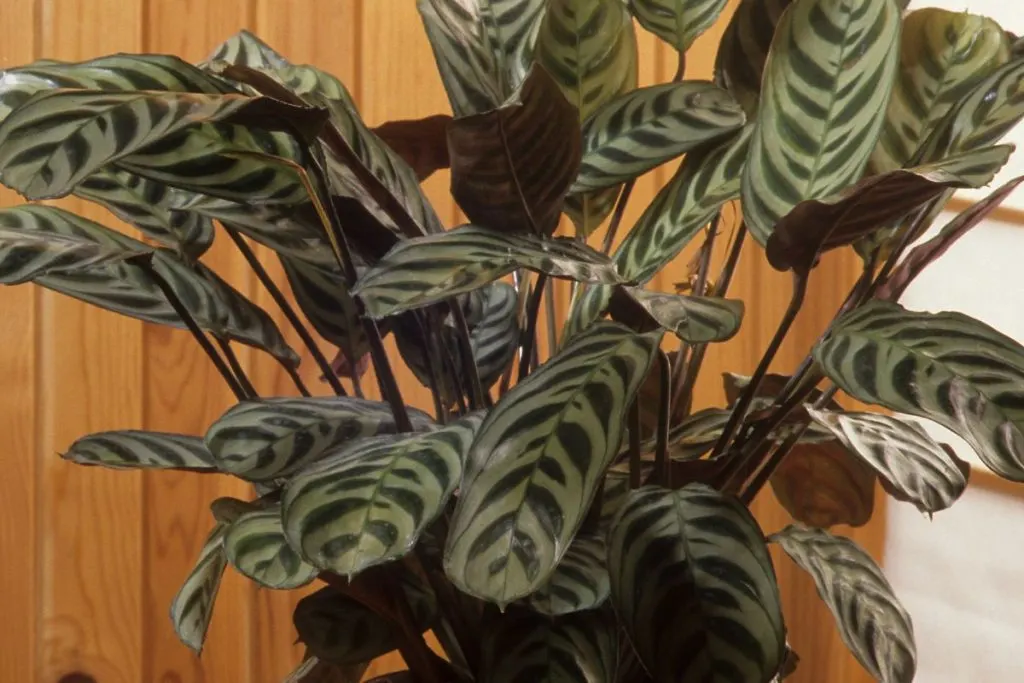
The name Calatheas Fishbone has not yet been determined. I am confident that this plant is more adaptable to light fluctuations than many other prayer-plants.
- Light Conditions
If the thin leaves of this plant are exposed to too much direct sunlight, they roll the leaves from the side to the inside.
Instead, place the terrarium containing this plant in a location with moderate or bright indirect light, diffused by clear curtains, or out of the way of harsh sunlight.
- Water Routine
Herringbone prayer plants are a dream plant for parents of over-watering plants. This plant is not a fan of flooding but may dislike further drying.
The substrate of this plant should be kept consistently moist so that only the top inch or 2 inches dry before it requires more water.
Your Ctenantheburle-marxii will surely live the best life in a closed terrarium along with other moisture-loving plants.
- Soil Type
The Ctenanthe Burle marxii plant resembles the old childhood story of Goldilocks in its substrate.
You’ll surely like the material because it retains moisture easily, but at the same time, it also improves drainage. The easiest way to do this is to mix pearlite, bark, or coir into the mix.
- Temperature And Humidity
Originally born in the humid tropical jungle of Brazil, the plant has evolved to live in a warm, fairly humid environment at all times.
Unlike Calatheas in the world, Ctenanthe Burle-marxii is slightly less needed in these areas and is built to survive a few days less than the cousins of the prayer plant family.
- Fertilizer
Liquid fertilizer for indoor plants is a simple and best choice for fishbone prayer-plants.
8. Herringbone Plant
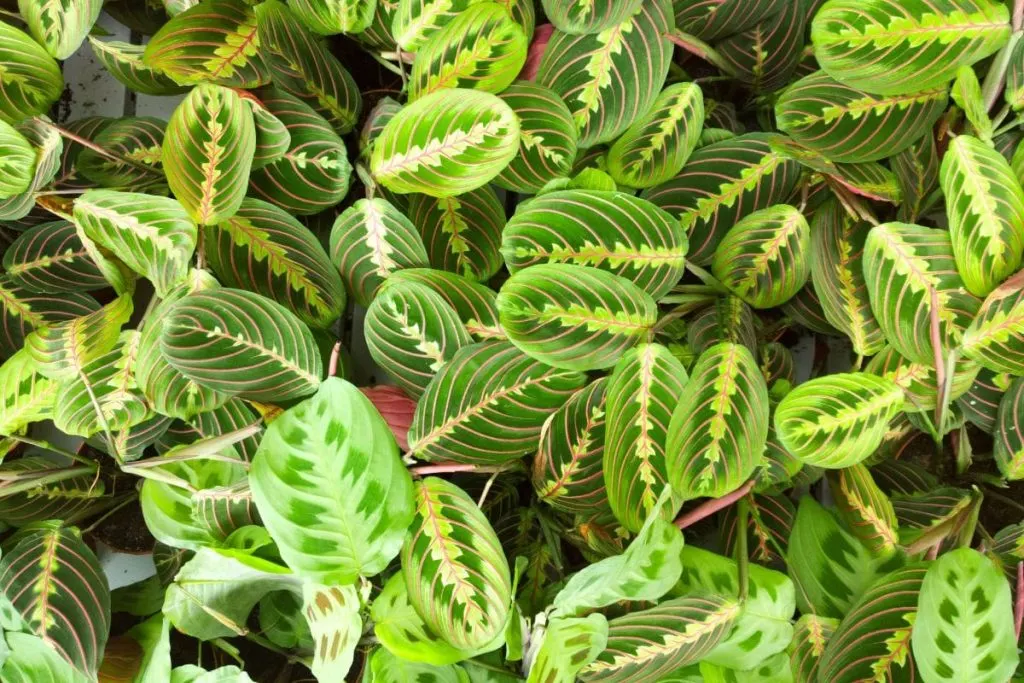
Maranta is a stunningly colorful decorative foliage plant. The oval leaves of the herringbone plant sometimes called Maranta Roy Coneu La Fascinator Tricolor, are incredibly unique.
The leaves are dark green in the center and faded to light green at the edges, with alternating light spots along the median plane.
The veins are an impressive red that runs through the center of the leaf and branches in a herringbone pattern.
- Light Conditions
Light Maranta grows best in bright indirect light but is strong enough to withstand some shade. Avoid direct sunlight, because the plant may be burned.
- Water Routine
Always keep the soil moist, but do not soak it in water or leave the plants moist. We recommend watering with soft, lukewarm water.
- Soil Type
The best possible choices are sphagnum peat moss, part loamy soil, and one part perlite or coarse sand. You can’t go wrong with these!
- Temperature And Humidity
Temperature between 65 and 70 F is perfect for this plant. Increased humidity is essential. Frequent fog occurs. The tips of the brown leaves are a sign that the surrounding air is too dry.
- Fertilizer
During the growing season, apply a balanced fertilizer once or twice a month.
9. Calathea Jungle Velvet
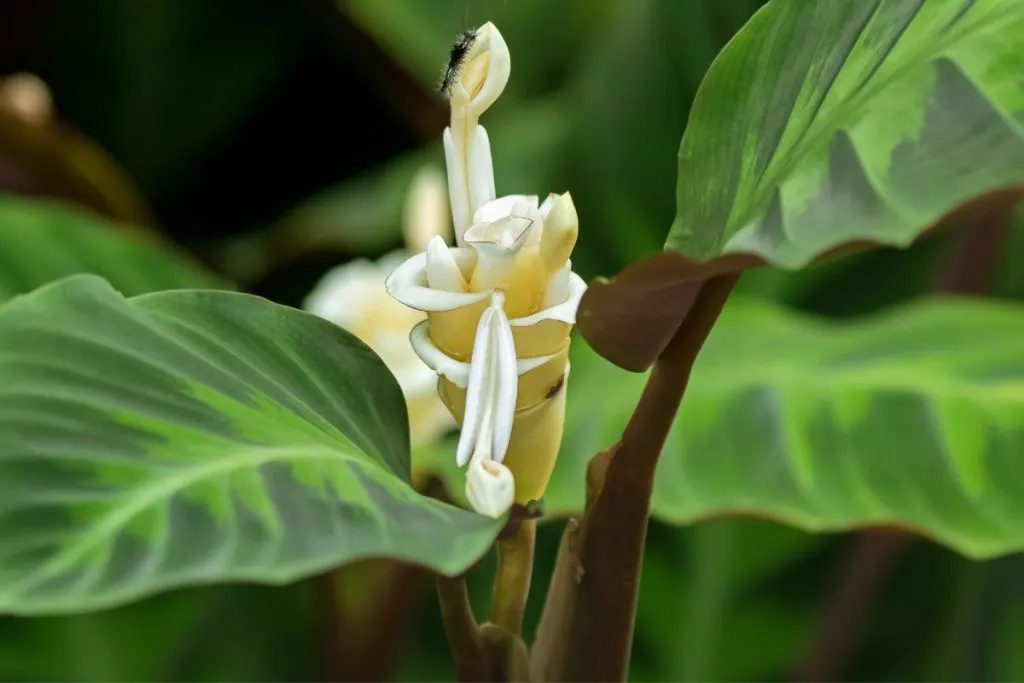
This Calacthea is a splendid tropical plant with stunningly patterned leaves. Calathea warscewiczii is one of the most notable varieties with exotic, velvety leaves, a two-colored green tip, and a burgundy underneath.
- Light Conditions
Moderate indirect sunlight Calatheas breed in moderate indirect sunlight, but can withstand less light.
Bright direct sunlight can lighten the stunning color of the leaves, and prolonged exposure to the sun can cause the leaves to burn and burn.
- Watering Routine
Calatheas enjoys weekly watering, partially drying the top two feet of the soil. In winter, it is advisable to reduce the frequency of watering to prevent watering and root rot. This plant is not very drought resistant and long-term droughts result in brown leaf edges.
- Soil Type
Peat moss and perlite mix are the best choices for a jungle Calathea. Sand and loamy soil shouldn’t be an option for this plant.
- Temperature And Humidity
Calatheas can also be placed in a humid environment that can be created by frequent fog, near other plants, or in a gravel tray partially filled with water. Calatheas thrives in sultry bathrooms and kitchens.
Wrapping It Up About Types Of Prayer Plants
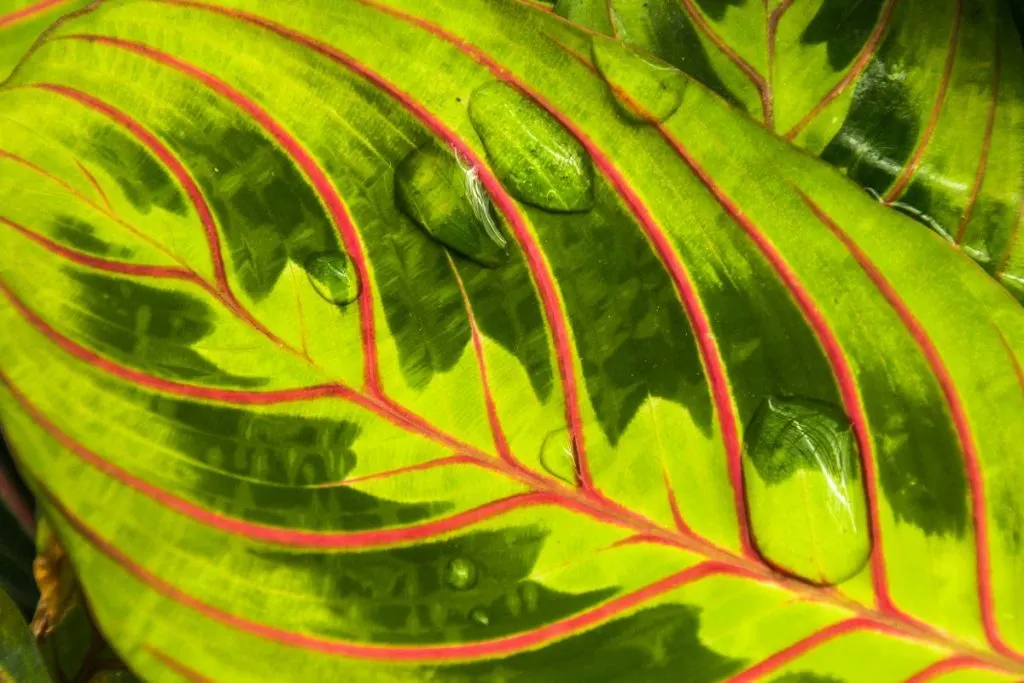
You’re still not sure if you want the light green background or pale green undersides? You have plenty of time to decide. You can read it as many times as you want before you choose and go buy one of them tomorrow.
I was in doubt between a classic prayer plant and calathea jungle velvet, and in the end, I got both of them. That solved I guess my “big” problem pretty easily.
I know it’s hard to choose a perfect tropical plant for your home. There is so much to think about: tiny flowers, purple markings, fine yellow markings, and many foliage patterns.
Sometimes, you’re thinking about your furniture as well and what goes well with it. It gets hard I know.
Well, you take your time and once you’re ready, choose the best one that suits you the most! You might find the perfect one between these types of prayer plants we presented to you.
That would be all for today! Until next time! See you soon!

